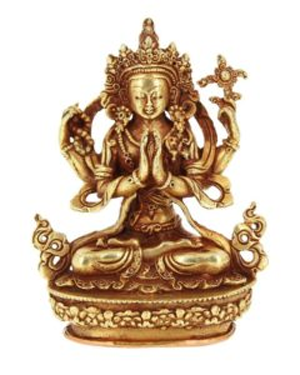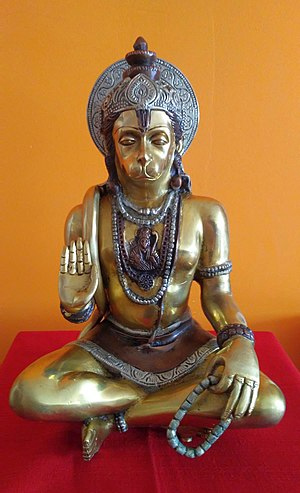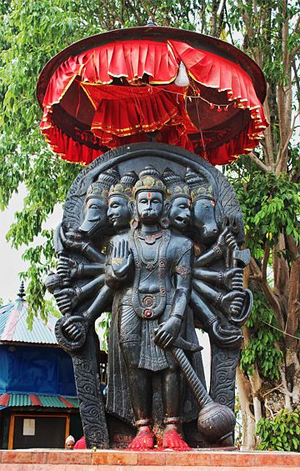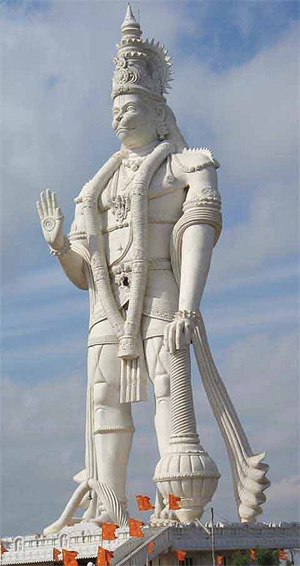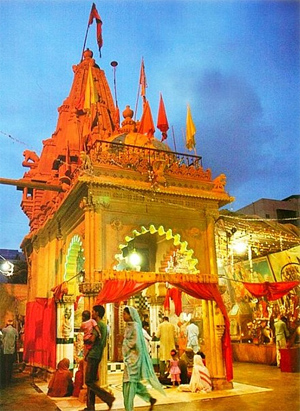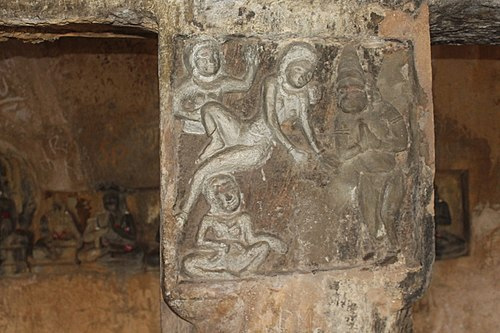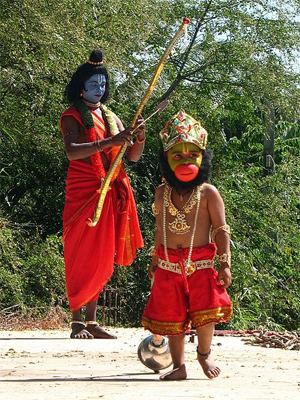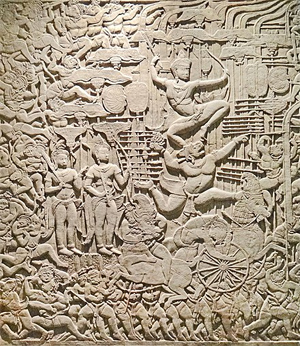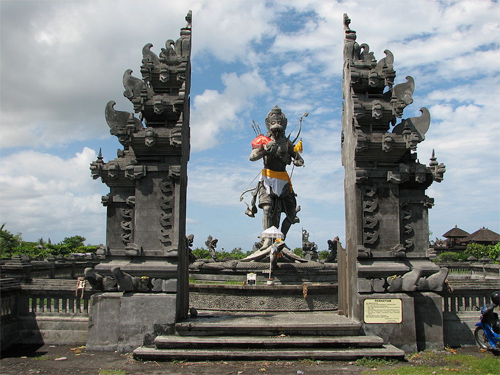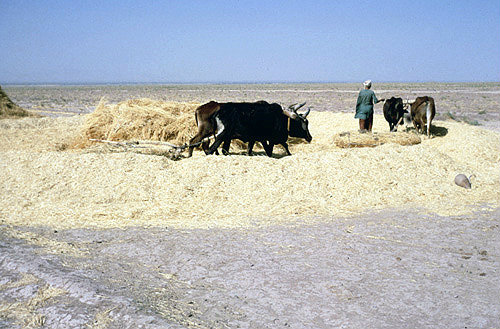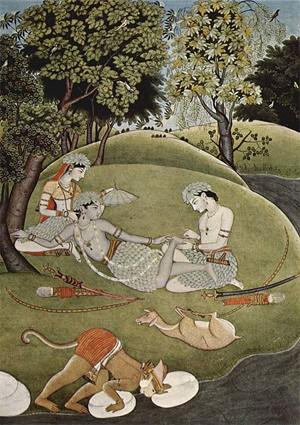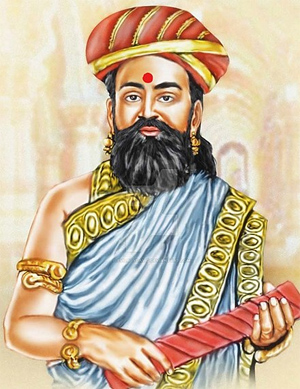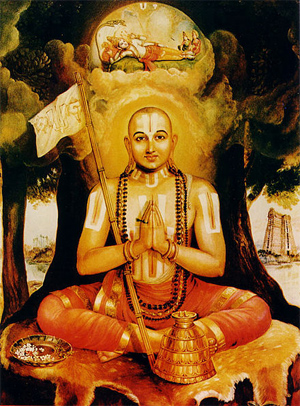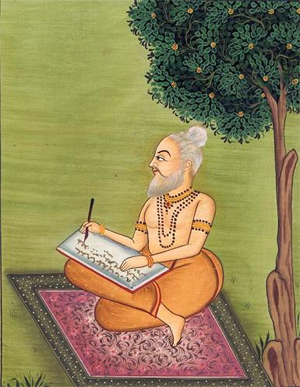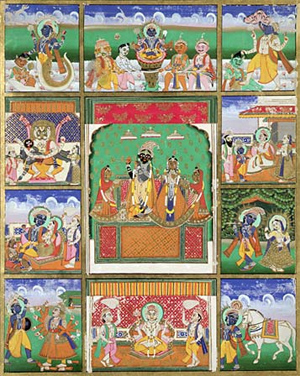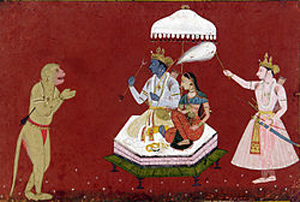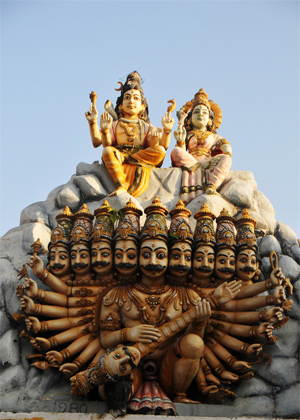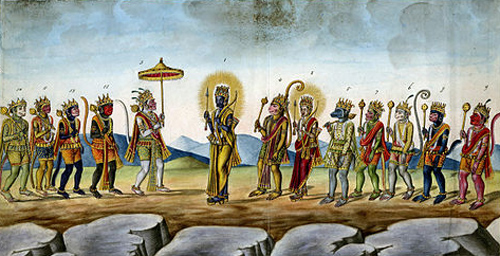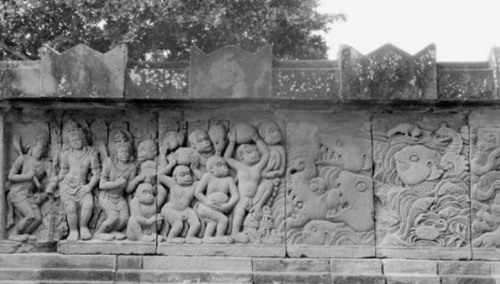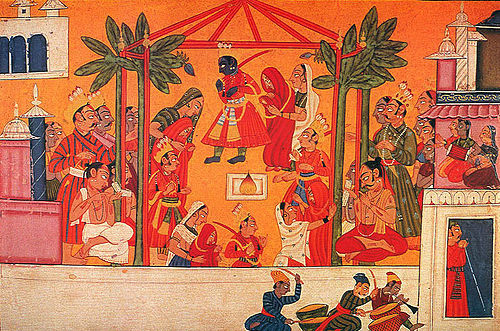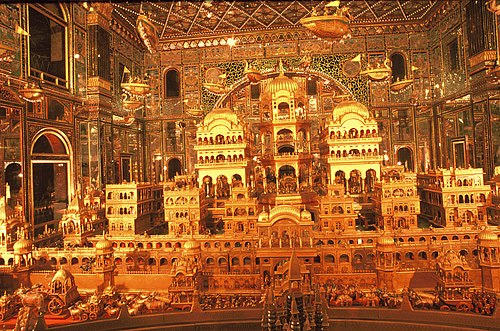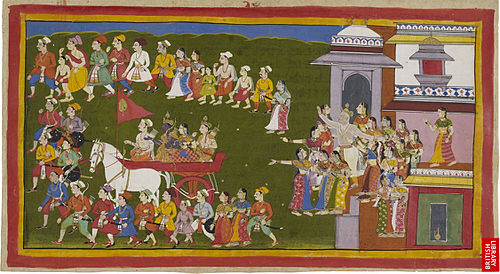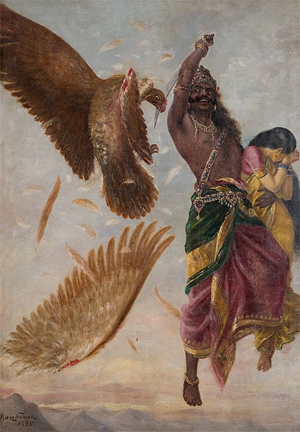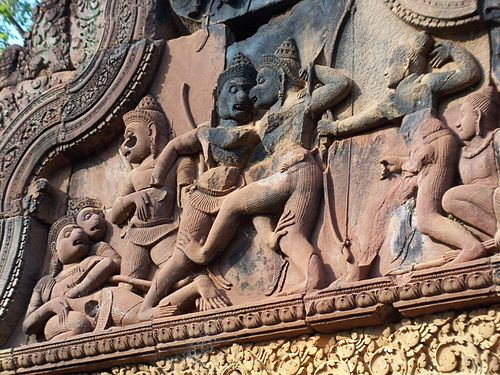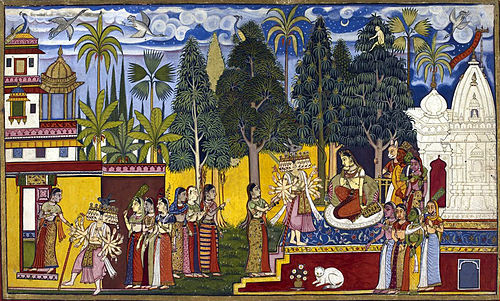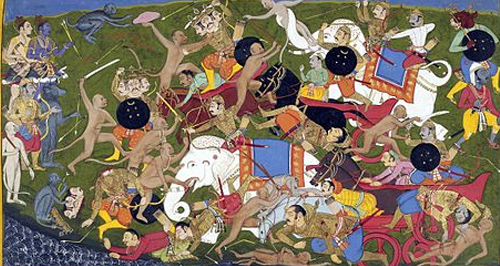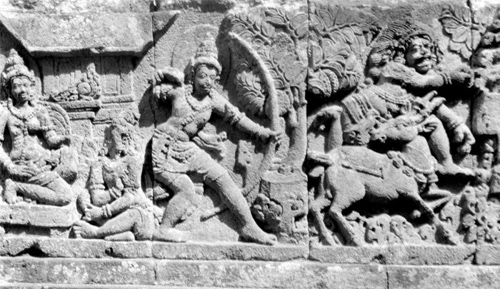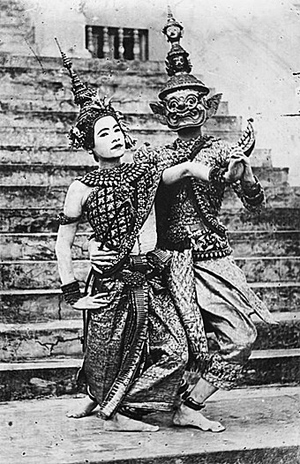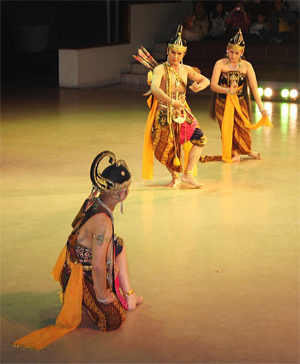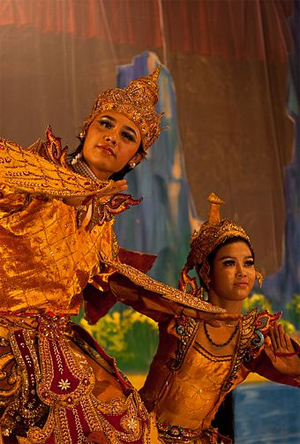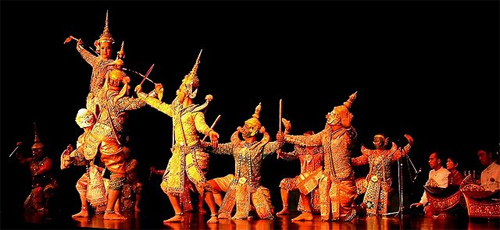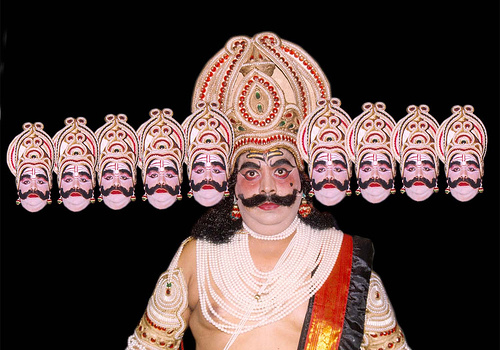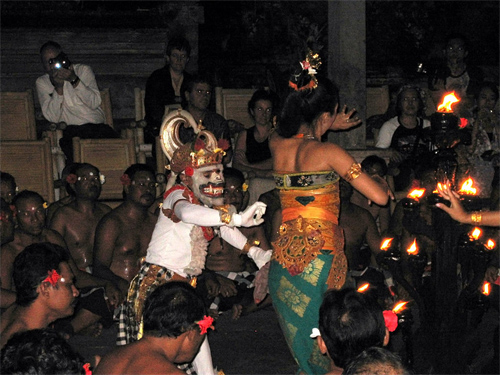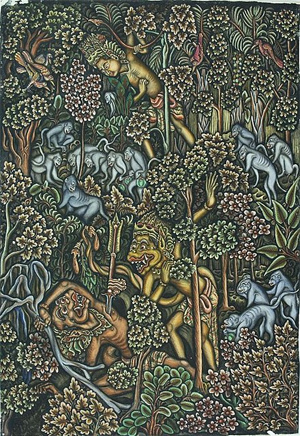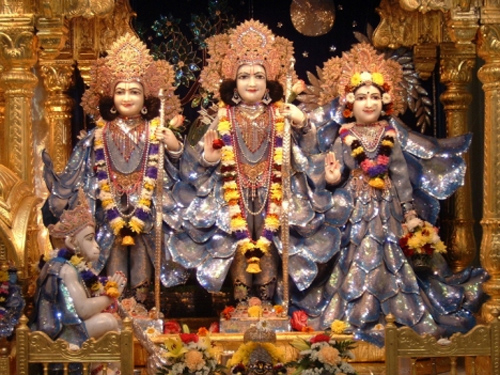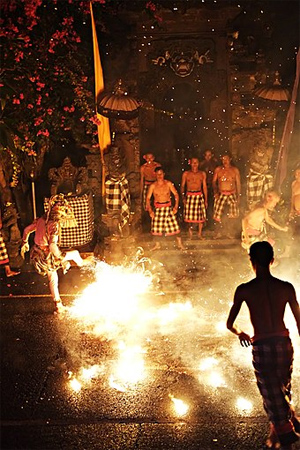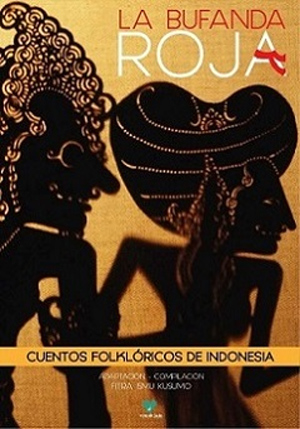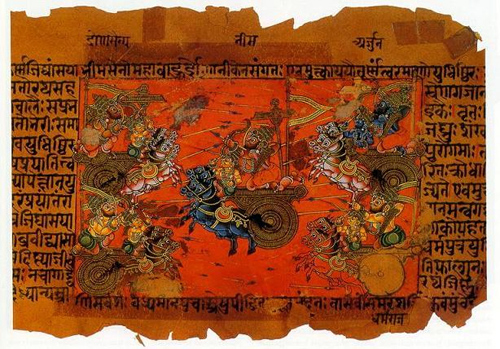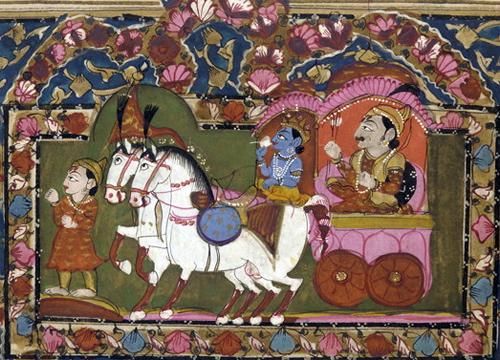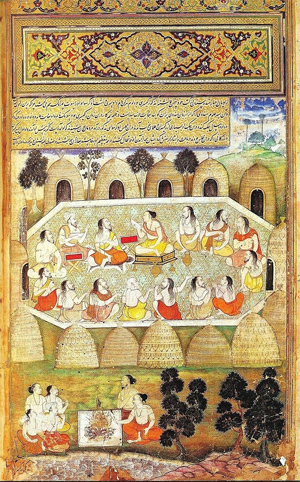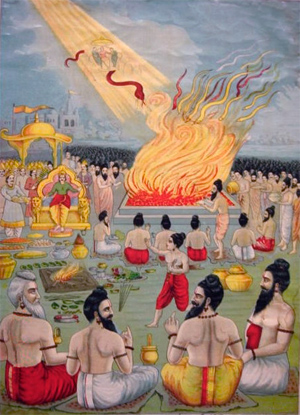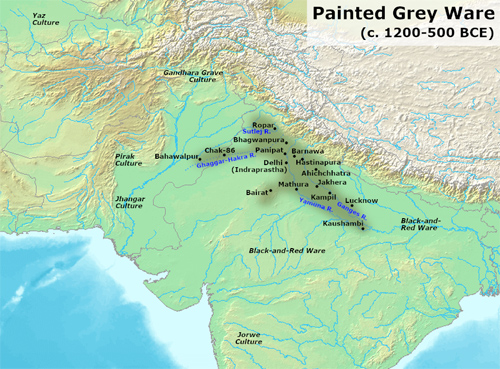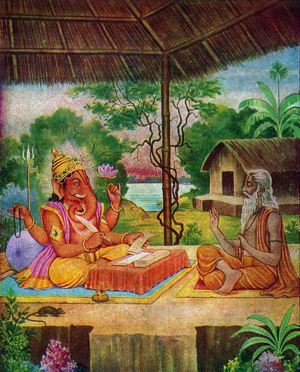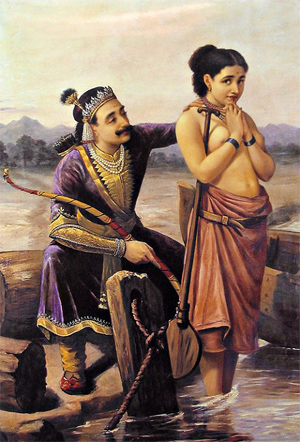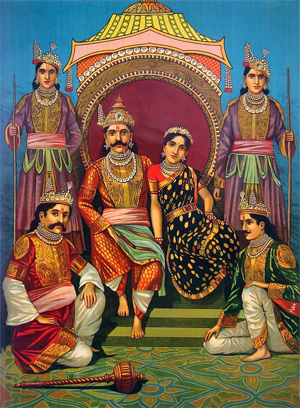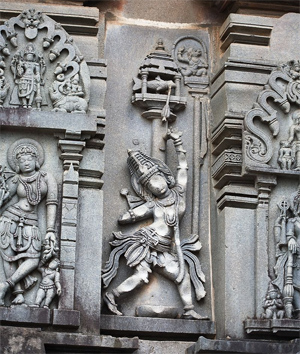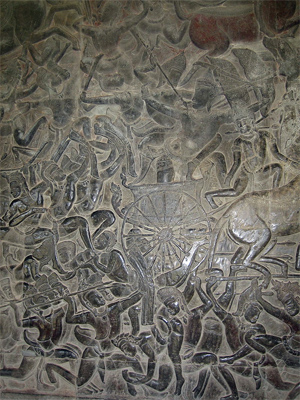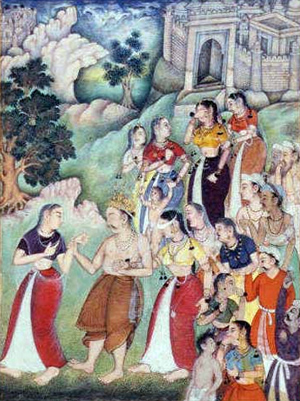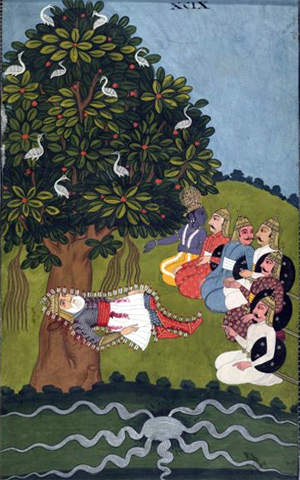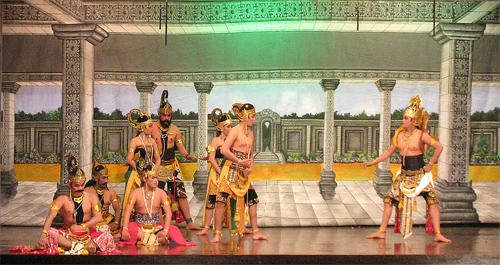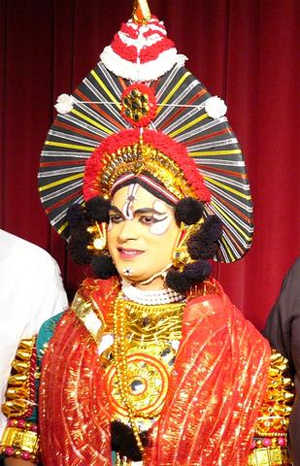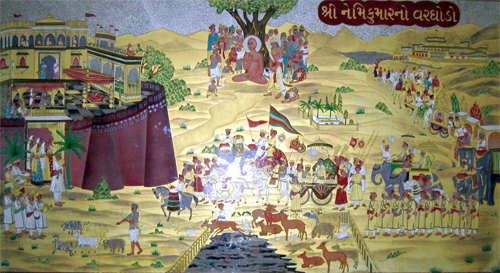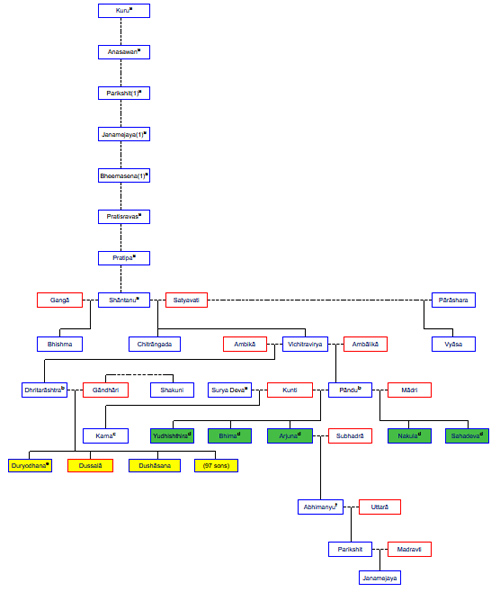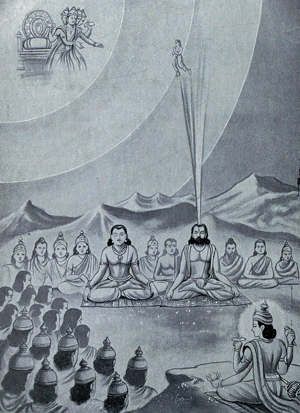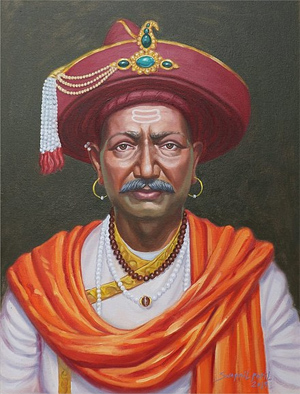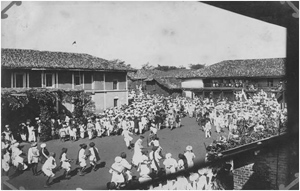Hanuman [Hanumat] [Anuman] [Hanumantha] [Hanumathudu]
by Wikipedia
Accessed: 5/16/21
Origin legend of the Tibetan people
Gods love to change to other forms, not just the classical legends of ancient Greece, the Native American tales, and the cosmic chaos household of Hinduism.
As in the Tibetan founding legend: Behind the two wild creatures of the monkey and the demon hide namely the bashful Chenrezig, Bodhisattva of compassion (in his Sanskrit form also called Avalokiteshvara) and his - even - better half Jetsün Dölma. Dölma is also known as Tara and is worshiped by Buddhists in all its 21 expressions, colors and powers.
Chenrezig, or Avalokiteshvara, the bodhisattva of compassion.
When not in the guise of a demon wrapped in raging wispy clouds and raving on mountain peaks, Dölma is a rather reserved, practical deity, merciful, full of love for her loved ones and proud of her femininity: As a mocking monk once advises her, the next To be born again as a man, for only in this way can one obtain the last enlightenment, does she swear from then on to reincarnate only as a female being.
When the Buddha of Compassion and the Goddess of Goodness meet on the Tibetan Plateau, both are already high spirits, yet unredeemed. A threefold rainbow is formed between their bodies and they look deeply into each other's eyes. And so that they do not need to be ashamed of each other in their exemplary purity as holy beings, one lets out the monkey and the other the demoness. We know the feeling.
Incarnation of feminine intuition: the green tara (thangka from the 13th century, Tibet).
Since it can still take until Nirvana, they not only agree to play heavenly love games and have six children with each other, but also to beget a whole people. However, although the monkey and the demon take care of their offspring, this one denies both monkey and demon food. Even that is not unknown to today's human parents.
Only when suddenly a field full of highland barley sprouts from the raw earth and the ears change into tsampa flour, the hunger of the children can be satisfied. From now on, the children of the monkey and the demon are true Tibetans.
-- Coocoola [Kukula] of Sikkim: Lacham Kusho, That's Going with the Gods, by Simon Schreyer
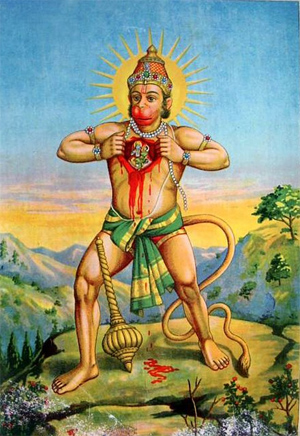
Hanuman
God of Wisdom, Strength, Courage, Devotion and Self-Discipline[1]
Hanuman tearing up his chest to show Sita-Rama in his heart
Devanagari: हनुमान
Sanskrit transliteration: Hanumān
Affiliation: Devotee of Rama, Deva, Vanara,[2] Rudra avatar
Mantra: ॐ हनुमते नमः (Om Hanumate Namah)
Weapon: Gada (mace)
Texts: Ramayana and its other versions, Hanuman Chalisa [3]
Festivals: Hanuman Jayanti
Personal information
Born: Anjeyanadri Hill, Koppal district, Karnataka
Parents: Vayu (celestial father); Kesari (father)[2][5]; Añjanā (mother)[2]
Siblings: Bhima (spiritual brother)[4]
Hanuman (/ˈhʌnʊˌmɑːn/; Sanskrit: हनुमान्, IAST: Hanumān)[6] is a Hindu god and divine vanara companion of the god Rama. Hanuman is one of the central characters of the Hindu epic Ramayana. He is an ardent devotee of Rama and one of the chiranjivis. Hanuman is also son of the wind-god Vayu, who in several stories played a direct role in Hanuman's birth.[5][7] Hanuman is mentioned in several other texts, such as the epic Mahabharata and the various Puranas.
Evidence of devotional worship to Hanuman is largely absent in these texts, as well as in most archeological sites. According to Philip Lutgendorf, an American Indologist, the theological significance of Hanuman and devotional dedication to him emerged about 1,000 years after the composition of the Ramayana, in the 2nd millennium CE, after the arrival of Islamic rule in the Indian subcontinent.[8] Lutgendorf also writes that the skills in Hanuman's resume also seem to derive in part from his windy patrimony, reflecting Vayu's role in both body and cosmos.[9] Bhakti movement saints such as Samarth Ramdas have positioned Hanuman as a symbol of nationalism and resistance to persecution.[10] The Vaishnava saint Madhva said that whenever Vishnu incarnates on earth, Vayu accompanies him and aids his work of preserving dharma.[11] In the modern era, Hanuman's iconography and temples have been increasingly common.[12] He is viewed as the ideal combination of "strength, heroic initiative and assertive excellence" and "loving, emotional devotion to his personal god Rama", as Shakti and Bhakti.[13] In later literature, he is sometimes portrayed as the patron god of martial arts such as wrestling and acrobatics, as well as activities such as meditation and diligent scholarship.[2] He symbolizes the human excellences of inner self-control, faith, and service to a cause, hidden behind the first impressions of a being who looks like an Ape-Man Vanara.[12][14][15] Hanuman is considered a bachelor and exemplary celibate.[16]
Some scholars have identified Hanuman as one potential inspiration for Sun Wukong, the Monkey King character in the Chinese epic adventure Journey to the West.[17][18]
Nomenclature

Hanuman with a Namaste (Anjali Mudra) posture
The meaning or origin of the word "Hanuman" is unclear. In the Hindu pantheon, deities typically have many synonymous names, each based on some noble characteristic, attribute, or reminder of a mythical deed achieved by that deity.[19] One interpretation of "Hanuman" is "one having a disfigured jaw". This version is supported by a Puranic legend wherein infant Hanuman mistakes the Sun for a fruit, heroically attempts to reach it, and is wounded in the jaw for his attempt.[19]
Hanuman combines two of the most cherished traits in the Hindu bhakti-shakti worship traditions: "heroic, strong, assertive excellence" and "loving, emotional devotion to personal God".[19]
Linguistic variations of "Hanuman" include Hanumat, Anuman (Tamil), Hanumantha (Kannada), Hanumanthudu (Telugu). Other names include:
• Anjaneya,[20] Anjaniputra (Kannada), Anjaneyar (Tamil), Anjaneyudu (Telugu), Anjanisuta all meaning "the son of Anjana"
• Kesari Nandana or Kesarisuta, based on his father, which means "son of Kesari"
• Vayuputra/ Pavanputra : the son of the Vayu deva-Wind god[21]
• Vajrang Bali/Bajrang Bali, "the strong one (bali), who had limbs (anga) as hard or as tough as vajra (diamond)"; this name is widely used in rural North India[19]
• Sankata Mochana, "the remover of dangers, hardships, or hurdles" (sankata)[19]
• Māruti, "son of Maruta" (another name of Vayu deva)
• Kapeeshwara, "lord of monkeys"
• Rama Doota, "the messenger (doota) of Lord Rama"
• Mahakaya, gigantic"
• Vira, Mahavira, "most valiant"
• Mahabala/Mahabali, "the strongest one"
• Panchavaktra, "five-faced"
• Mukhya Prana Devaru, "Primordial Life Giver" (more prominent amongst followers of Dvaita, such as Madhwas)
Historical development
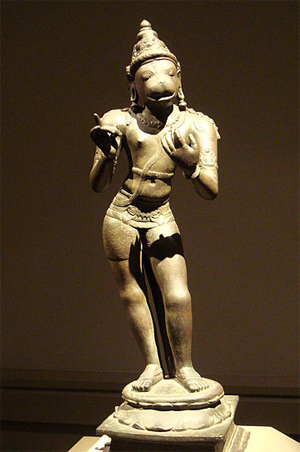
Standing Hanuman, Chola Dynasty, 11th century, Tamil Nadu, India
Vedic roots
The earliest mention of a divine monkey, interpreted by some scholars as the proto-Hanuman, is in hymn 10.86 of the Rigveda [???!!!], dated to between 1500 and 1200 BCE. The twenty-three verses of the hymn are a metaphorical and riddle-filled legend. It is presented as a dialogue between multiple characters: the god Indra, his wife Indrani and an energetic monkey it refers to as Vrisakapi and his wife Kapi.[22][23][24] The hymn opens with Indrani complaining to Indra that some of the soma offerings for Indra have been allocated to the energetic and strong monkey, and the people are forgetting Indra. The king of the gods, Indra, responds by telling his wife that the living being (monkey) that bothers her is to be seen as a friend, and that they should make an effort to coexist peacefully. The hymn closes with all agreeing that they should come together in Indra's house and share the wealth of the offerings.
HYMN LXXXVI. Indra.
1. MEN have abstained from pouring juice they count not Indra as a God.
Where at the votary's store my friend Vrsakapi hath drunk his fill. Supreme is Indra over all.
2 Thou, Indra, heedless passest by the ill Vrsakapi hath wrought;
Yet nowhere else thou findest place wherein to drink the Soma juice. Supreme is Indra over all.
3 What hath he done to injure thee, this tawny beast Vrsakapi,
With whom thou art so angry now? What is the votary's foodful store? Supreme is Indra over all.
4 Soon may the hound who hunts the boar seize him and bite him in the car,
O Indra, that Vrsakapi whom thou protectest as a friend, Supreme is Indra over all.
5 Kapi hath marred the beauteous things, all deftly wrought, that were my joy.
In pieces will I rend his head; the sinner's portion shall he woo. Supreme is Indra over all.
6 No Dame hath ampler charms than I, or greater wealth of love's delights.
None with more ardour offers all her beauty to her lord's embrace. Supreme is Indra over all.
7 Mother whose love is quickly won, I say what verily will be.
My, breast, O Mother, and my head and both my hips seem quivering. Supreme is Indra over all.
8 Dame with the lovely hands and arms, with broad hair-plaits add ample hips,
Why, O thou Hero's wife, art thou angry with our Vrsakapi? Supreme is Indra over all.
9 This noxious creature looks on me as one bereft of hero's love,
Yet Heroes for my sons have I, the Maruts’ Friend and Indra's Queen. Supreme is Indra over all.
10 From olden time the matron goes to feast and general sacrifice.
Mother of Heroes, Indra's Queen, the rite's ordainer is extolled. Supreme is Indra over all.
11 So have I heard Indrāṇī called most fortunate among these Dames,
For never shall her Consort die in future time through length of days. Supreme is Indra overall.
12 Never, Indralni, have I joyed without my friend Vrsakapi,
Whose welcome offering here, made pure with water, goeth to the Gods. Supreme is Indra over all.
13 Wealthy Vrsakapayi, blest with sons and consorts of thy sons,
Indra will eat thy bulls, thy dear oblation that effecteth much. Supreme is Indra over all.
14 Fifteen in number, then, for me a score of bullocks they prepare,
And I devour the fat thereof: they fill my belly full with food. Supreme is Indra over all.
15 Like as a bull with pointed horn, loud bellowing amid the herds,
Sweet to thine heart, O Indra, is the brew which she who tends thee pours. Supreme is Indra over all.
18 O Indra this Vrsakapi hath found a slain wild animal,
Dresser, and new-made pan, and knife, and wagon with a load of wood. Supreme is Indra over all.
19 Distinguishing the Dāsa and the Ārya, viewing all, I go.
I look upon the wise, and drink the simple votary's Soma juice. Supreme is Indra over all.
20 The desert plains and steep descents, how many leagues in length they spread!
Go to the nearest houses, go unto thine home, Vrsakapi. Supreme is Indra over all.
21 Turn thee again Vrsakapi: we twain will bring thee happiness.
Thou goest homeward on thy way along this path which leads to sleep. Supreme is Indra over all.
22 When, Indra and Vrsakapi, ye travelled upward to your home,
Where was that noisome beast, to whom went it, the beast that troubles man? Supreme is Indra over all.
23 Daughter of Manu, Parsu bare a score of children at a birth.
Her portion verily was bliss although her burthen caused her grief.
-- The Rig Veda, translated by Ralph T. H. Griffith
Proto Dravidian roots
The orientalist F. E. Pargiter (1852–1927) theorized that Hanuman was a proto-Dravidian deity.[25] According to this theory, the name "Hanuman" derives from Tamil word for male monkey (ana-mandi), first transformed to "Anumant" – a name which remains in use. "Anumant", according to this hypothesis, was later Sanskritized to "Hanuman" because the ancient Aryans confronted with a popular monkey deity of ancient Dravidians coopted the concept and then Sanskritized it.[24][26] According to Murray Emeneau, known for his Tamil linguistic studies, this theory does not make sense because the Old Tamil word mandi in Caṅkam literature can only mean "female monkey", and Hanuman is male. Further, adds Emeneau, the compound ana-mandi makes no semantic sense in Tamil, which has well developed and sophisticated grammar and semantic rules. The "prominent jaw" etymology, according to Emeneau, is therefore plausible.[24]
Epics and Puranas
Sita's scepticism
Vanaranam naranam ca
kathamasit samagamah
Translation:
How can there be a
relationship between men and monkeys?
—Valmiki's Ramayana'
Sita's first meeting with Hanuman
(Translator: Philip Lutgendorf)[27]
Hanuman is mentioned in both the Hindu epics, Ramayana and Mahabharata.[28] A twentieth-century Jesuit missionary Camille Bulcke, in his Ramkatha: Utpatti Aur Vikas ("The tale of Rama: its origin and development"), proposed that Hanuman's worship had its basis in the cults of aboriginal tribes of Central India.[29]
Hanuman is mentioned in the Puranas.[30] A medieval legend posited Hanuman as an avatar of the god Shiva by the 10th century CE, but at first we find only a mere mention of the fact that Hanuman is Rudravatara according to most of the puranas.[29][31] Hanuman is mentioned as an avatar of Rudra in the medieval era Sanskrit texts like the Bhagavata Purana, the Skanda Purana, the Brhaddharma Purana and the Mahanataka among others.
Rudra (/ˈrʊdrə/; Sanskrit: रुद्र) is a Rigvedic deity associated with wind or storm, Vayu and the hunt. One translation of the name is 'the roarer'. In the Rigveda, Rudra is praised as the 'mightiest of the mighty'. Rudra means "who eradicates problems from their roots". Depending upon the periodic situation, Rudra can mean 'the most severe roarer/howler' (could be a hurricane or tempest) or 'the most frightening one'. Rudra is described as the lord who does total destruction at the time of great dissolution. The Shri Rudram hymn from the Yajurveda is dedicated to Rudra and is important in the Saivism sect.
-- Rudra, by Wikipedia
Rudra (Tib. རུ་དྲ་, Wyl. ru dra) is a demon who embodies egohood.
-- Rudra, by rigpawiki.org
Only Shiva Purana mentions Hanuman as an avatar of Shiva; all other puranas clearly mention that he is an avatar of Rudra (which is also another name of Vayu[32]).[29] Indologist Philip Lutgendorf writes, "The later identification of Hanuman as one of the eleven rudras may reflect a Shaiva sectarian claim on an increasing popular god, it also suggests his kinship with, and hence potential control over, a class of awesome and ambivalent deities". Lutgendorf also writes, "Other skills in Hanuman's resume also seem to derive in part from his windy patrimony, reflecting Vayu's role in both body and cosmos".[9]
Other mythologies, such as those found in South India, present Hanuman as a being who is the union of Shiva and Vishnu, or associated with the origin of Ayyappa.[2] The 17th century Odia work Rasavinoda by Dinakrishnadasa goes on to mention that the three gods – Brahma, Vishnu and Shiva – combined to take to the form of Hanuman.[33]
Late medieval and modern era
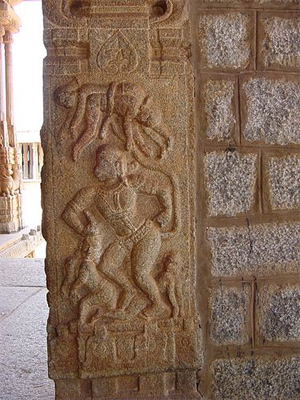
Numerous 14th-century and later Hanuman images are found in the ruins of the Hindu Vijayanagara Empire.[34]
In Valmiki's Ramayana, estimated to have been composed before or in about the 3rd century BCE, Hanuman is an important, creative character as a simian helper and messenger for Rama. The character evolved over time, reflecting regional cultural values. It is, however, in the late medieval era that his profile evolves into more central role and dominance as the exemplary spiritual devotee, particularly with the popular vernacular text Ramcharitmanas by Tulsidas (~ 1575 CE).[21][35] According to scholars such as Patrick Peebles and others, during a period of religious turmoil and Islamic rule of the Indian subcontinent, the Bhakti movement and devotionalism-oriented Bhakti yoga had emerged as a major trend in Hindu culture by the 16th-century, and the Ramcharitmanas presented Rama as a Vishnu avatar, supreme being and a personal god worthy of devotion, with Hanuman as the ideal loving devotee with legendary courage, strength and powers.[10][36]
During this era, Hanuman evolved and emerged as the ideal combination of shakti and bhakti.[13] Stories and folk traditions in and after the 17th century, began to reformulate and present Hanuman as a divine being, as a descendant of deities, and as an avatar of Shiva.[36] He emerged as a champion of those religiously persecuted, expressing resistance, a yogi,[37] an inspiration for martial artists and warriors,[38] a character with less fur and increasingly human, symbolizing cherished virtues and internal values, and worthy of devotion in his own right.[10][39] As Hindu monks morphed into soldiers, they often named their organizations after Hanuman.[40][41] This evolution of Hanuman's character, his religious status, and his cultural role as well as his iconography, continued through the colonial era and into post-colonial times.[42]
Legends
Birth
According to Hindu legends, Hanuman was born to mother Anjana and father Kesari.[2][43] Hanuman is also called the son of the deity Vayu (Wind god) because of legends associated with Vayu's role in Hanuman's birth. One story mentioned in Eknath's Bhavartha Ramayana (16th century CE) states that when Anjana was worshiping Vayu, the King Dasharatha of Ayodhya was also performing the ritual of Putrakameshti yagna in order to have children. As a result, he received some sacred pudding (payasam) to be shared by his three wives, leading to the births of Rama, Lakshmana, Bharata and Shatrughna. By divine ordinance, a kite snatched a fragment of that pudding and dropped it while flying over the forest where Anjana was engaged in worship. Vayu, the Hindu deity of the wind, delivered the falling pudding to the outstretched hands of Anjana, who consumed it, leading to the birth of Hanuman.[43]
The Ramayana locates the birthplace of Hanuman in Kishkinda. Anjaneri in Nasik, Maharashtra[44][45][46] along with Anjeneri Anjanadri (Near Hampi) in Gangavathi Taluk Koppal District, Karnataka is one of a number of places that claim to be the location of Kishkinda.[47][48][49]
Childhood
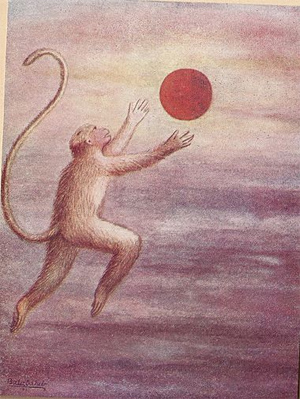
Child Hanuman reaches for the Sun thinking it is a fruit by BSP Pratinidhi
According to Valmiki's Ramayana, one morning in his childhood, Hanuman was hungry and saw the rising red-colored sun. Mistaking it for a ripe fruit, he leapt up to eat it. In one version of the Hindu legend, the king of gods Indra intervened and struck Hanuman with his thunderbolt. It hit Hanuman on his jaw, and he fell to the earth dead with a broken jaw. According to the Ramayana (section 4.65), Hanuman's father Vayu (air) became upset and withdrew all the air on Earth. The lack of air created immense suffering to all living beings. This led lord Shiva to intervene and resuscitate Hanuman, which in turn prompted Vayu to return to the living beings. As the mistake was done by the god Indra, he grants Hanuman a wish that his body would be as strong as Indra's Vajra, and that his Vajra can also not harm him. Along with Indra other gods have also granted him wishes: the God Agni granted Hanuman a wish that fire won't harm him; God Varuna granted a wish for Hanuman that water won't harm him; God Vayu granted a wish for Hanuman that he will be as fast as wind and the wind won't harm him. Lord Brahma also granted Hanuman a wish that he can move to any place where he cannot be stopped; Lord Vishnu also grants Hanuman a weapon named "Gada". Hence these wishes make Hanuman an immortal, who has unique powers and strength.[50]
In another Hindu version of his childhood legend, which Lutgendorf states is likely older and also found in Jain texts such as the 8th-century Dhurtakhyana, Hanuman's Icarus-like leap for the sun proves to be fatal and he is burnt to ashes from the sun's heat. His ashes fall onto the earth and oceans.[51] Gods then gather the ashes and his bones from land and, with the help of fishes, re-assemble him. They find everything except one fragment of his jawbone. His great-grandfather on his mother's side then asks Surya to restore the child to life. Surya returns him to life, but Hanuman is left with a disfigured jaw.[51] Hanuman is said to have spent his childhood in Kishkindha.
Some time after this event, Hanuman begins using his supernatural powers on innocent bystanders as simple pranks, until one day he pranks a meditating sage. In fury, the sage curses Hanuman to forget the vast majority of his powers. The curse remains into effect, until he is reminded of his powers in his adulthood.
Adulthood
Ramayana
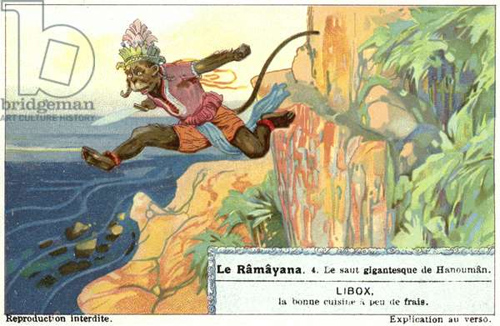
The giant leap of Hanuman to Lanka
There is quite a lot of variation between what happens between his childhood and the events of the Ramayana, but his story becomes much more solid in the events of the Ramayana. After Rama and his brother Lakshmana, searching for Rama's kidnapped wife, Sita, arrive in Kishkindha, the new king, and Rama's newfound ally the monkey king Sugriva, agree to send scouts in all four directions to search for Rama's missing wife. To the south, Sugriva sends Hanuman and some others, including the great bear Jambavan. This group travels all the way to the southernmost tip of India, where they encounter the ocean with the island of Lanka (modern day Sri Lanka) visible in the horizon. The group wishes to investigate the island, but none can swim or jump so far (it was common for such supernatural powers to be common amongst characters in these epics). However, Jambavan knows from prior events that Hanuman used to be able to do such a feat with ease, and lifts his curse.[52]
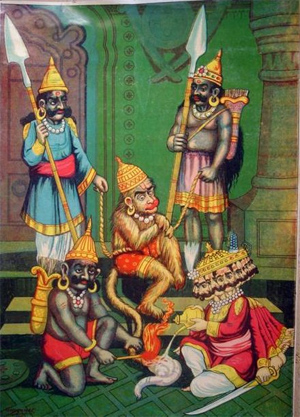
Ravana burns Hanuman's tail.
The curse lifted, Hanuman now remembers all of his dynamic divine powers. He is said to have transformed into the size of mountain, and flew across the narrow channel to Lanka. Upon landing, he discovers a city populated by the Lanka king Ravana and his demon followers, so he shrinks down to the size of an ant and sneaks into the city. After searching the city, he discovers Sita in a grove, guarded by demon warriors. When they all fall asleep, he meets with Sita and discusses how he came to find her. She reveals that Ravana kidnapped her and is forcing her to marry him soon. He offers to rescue her but Sita refuses, stating that her husband must do it (a belief from the time of ancient India).[52][53]
What happens next differs by account, but a common tale is that after visiting Sita, he starts destroying the grove, prompting his capture. Regardless of the tale, he ends up captured in the court of Ravana himself, who laughs when Hanuman tells him that Rama is coming to take back Sita. Ravana orders his servants to light Hanuman's tail on fire as torture for threatening his safety. However, every time they put on an oil-soaked cloth to burn, he grows his tail longer so that more clothes need to be added. This continues until Ravana has had enough and orders the lighting to begin. However, when his tail is lit, he shrinks his tail back and breaks free of his bonds with his superhuman strength. He jumps out a window and jumps from rooftop to rooftop, burning down building after building, until much of the city is ablaze. Seeing this triumph, Hanuman leaves back for India.[52][53]
Upon returning, he tells his scouting party what had occurred, and they rush back to Kishkindha, where Rama had been waiting all along for news. Upon hearing that Sita was safe and was awaiting him, Rama gathered the support of Sugriva's army and marched for Lanka. Thus begins the legendary Battle of Lanka.[52]
Throughout the long battle, Hanuman played a role as a general in the army. During one intense fight, Lakshmana, Rama's brother, was fatally wounded; it was thought that he would die without the aid of an herb from a Himalayan mountain. Hanuman was the only one who could make the journey so quickly, and was thus sent to the mountain.
Upon arriving, he discovered that there were many herbs along the mountainside, and did not want to take the wrong herb back. So instead, he grew to the size of a mountain, ripped the mountain from the Earth, and flew it back to the battle. This act is perhaps his most legendary among Hindus.[53] A chunk of this mountain was said to be fallen down while carrying and the present day “Mount Roomassala” is believed to be the fallen piece.
In the end, Rama revealed his divine powers as the incarnation of the God Vishnu, and slew Ravana and the rest of the demon army. Finally finished, Rama returned to his home of Ayodhya to return to his place as king. After blessing all those who aided him in the battle with gifts, Rama gave Hanuman his gift, who threw it away. Many court officials, perplexed, were angered by this act. Hanuman replied that rather than needing a gift to remember Rama, he would always be in his heart. Some court officials, still upset, asked him for proof, and Hanuman tore open his chest, which had an image of Rama and Sita on his heart. Now proven as a true devotee, Rama cured him and blessed him with immortality, but Hanuman refused this and asked only for a place at Rama's feet to worship him. Touched, Rama blessed him with immortality anyway. Like Shesha Nag, Hanuman would live on after the Kalpa (destruction of the universe).[52][53]
Shesha (Sanskrit: Śeṣa), also known as Sheshanaga (Śeṣanāga) or Adishesha (Ādi Śeṣa), is the nagaraja or King of all Nāgas and one of the primal beings of creation. In the Puranas, Shesha is said to hold all the planets of the universe on his hoods and to constantly sing the glories of the God Vishnu from all his mouths. He is sometimes referred to as Ananta Shesha, which translates as endless-Shesha or Adishesha "first Shesha". It is said that when Adishesa uncoils, time moves forward and creation takes place; when he coils back, the universe ceases to exist.
Vishnu is often depicted as resting on Shesha. Shesha is considered a devotee or bhakt of Vishnu. He is said to have descended to Earth in the human forms or avatars: Lakshmana, brother of Vishnu's avatar Rama during Treta Yuga, and as Balarama, brother of Vishnu's avatar Krishna during Dvapara Yuga. According to the Mahabharata (Adi Parva), his father was Kashyapa and his mother Kadru.
"Shesha" in Sanskrit texts, especially those relating to mathematical calculation, implies the "remainder"—that which remains when all else ceases to exist.
-- Shesha, by Wikipedia
Mahabharata
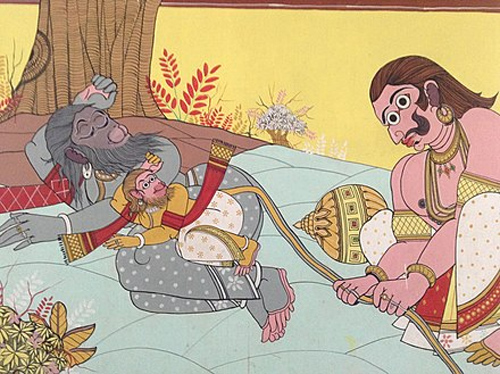
Bhima tries to lift Hanuman's tail.
Centuries after the events of the Ramayana, and during the events of the Mahabharata, Hanuman is now a nearly forgotten demigod living his life in a forest. After some time, his spiritual brother through the god Vayu, Bhima, passes through looking for flowers for his wife. Hanuman senses this and decides to teach him a lesson, as Bhima had been known to be boastful of his superhuman strength (at this point in time supernatural powers were much rarer than in the Ramayana but still seen in the Hindu epics). Bhima encountered Hanuman lying on the ground in the shape of a feeble old monkey. He asked Hanuman to move, but he would not. As stepping over an individual was considered extremely disrespectful in this time, Hanuman suggested lifting his tail up to create a passage. Bhima heartily accepted, but could not lift the tail to any avail.[54]
Bhima, humbled, realized that the frail monkey was some sort of deity, and asked him to reveal himself. Hanuman revealed himself, much to Bhima's surprise, and the brothers embraced. Hanuman prophesied that Bhima would soon be a part of a terrible war, and promised Bhima that he would sit on the flag of his brother Arjuna's chariot and shout a battle cry for Bhima that would weaken the hearts of his enemies. Content, Hanuman left his brother to his search, and after that prophesied war, would not be seen again until early 1600s.
Attributes
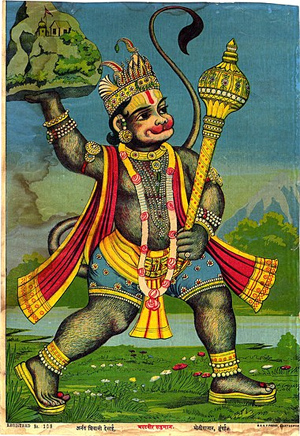
Hanuman fetches the herb-bearing mountain, in a print from the Ravi Varma Press, 1910s
Hanuman has many attributes, including:
• Chiranjivi (immortal): various versions of Ramayana and Rama Katha state towards their end, just before Rama and Lakshmana die, that Hanuman is blessed to be immortal. He will be a part of humanity forever, while the story of Rama lives on and the story will go on as the gods recite the story always. Thus, he will live forever.[55]
• Brahmachari (self-controlled): one who control their lust from all materialistic things of material world.
• Kurūp and Sundar: he is described in Hindu texts as kurūp (ugly) on the outside, but divinely sundar (beautiful inside).[51] The Hanuman Chalisa describes him as handsome with a complexion of molten gold (kanchana barana birāja subesā).[56]
• Kama-rupin: He can shapeshift, become smaller than the smallest, larger than the largest adversary at will.[57] He uses this attribute to shrink and enter Lanka, as he searches for the kidnapped Sita imprisoned in Lanka. Later on, he takes on the size of a mountain, blazing with radiance, to show his true power to Sita.[58]
• Strength: Hanuman is extraordinarily strong, one capable of lifting and carrying any burden for a cause. He is called Vira, Mahavira, Mahabala and other names signifying this attribute of his. During the epic war between Rama and Ravana, Rama's brother Lakshmana is wounded. He can only be healed and his death prevented by a herb found in a particular Himalayan mountain. Hanuman leaps and finds the mountain. There, states Ramayana, Hanuman finds the mountain is full of many herbs. He doesn't know which one to take. So, he lifts the entire Himalayan mountain and carries it across India to Lanka for Lakshmana. His immense strength thus helps Lakshmana recover from his wound.[59] This legend is the popular basis for the iconography where he is shown flying and carrying a mountain on his palm.[60]
• Innovative: Hanuman is described as someone who constantly faces very difficult odds, where the adversary or circumstances threaten his mission with certain defeat and his very existence. Yet he finds an innovative way to turn the odds. For example, after he finds Sita, delivers Rama's message, and persuades her that he is indeed Rama's true messenger, he is discovered by the prison guards. They arrest Hanuman, and under Ravana's orders take him to a public execution. There, the Ravana's guards begin his torture, tie his tail with oiled cloth and put it on fire. Hanuman then leaps, jumps from one palace rooftop to another, thus burning everything down.[61]
• Bhakti: Hanuman is presented as the exemplary devotee (bhakta) of Rama and Sita. The Hindu texts such as the Bhagavata Purana, the Bhakta Mala, the Ananda Ramayana and the Ramacharitmanas present him as someone who is talented, strong, brave and spiritually devoted to Rama.[62] The Rama stories such as the Ramayana and the Ramacharitmanas, in turn themselves, present the Hindu dharmic concept of the ideal, virtuous and compassionate man (Rama) and woman (Sita) thereby providing the context for attributes assigned therein for Hanuman.[63][64]
• Learned Yogi: In the late medieval texts and thereafter, such as those by Tulasidas, attributes of Hanuman include learned in Vedanta philosophy of Hinduism, the Vedas, a poet, a polymath, a grammarian, a singer and musician par excellence.[62][2]
• Remover of obstacles: in devotional literature, Hanuman is the remover of difficulties.[62]
• Bestower of eight Siddhis and nine Nidhis to his devotees: Hanuman is described as the bestower of eight classical Siddhis and nine Nidhis, a boon granted to him by Sita, and also famously described by Goswami Tulsidas in his devotional hymn named Hanuman Chalisa - "अष्ट सिद्धि नौ निधि के दाता। अस बर दीन्ह जानकी माता॥ ३१ ॥".
• Healer of diseases, pains and sorrows: Heals all kinds of diseases, pains and sorrows of devotees.
• Slayer of demons, evil and negative energies: Keeps away ghosts, evil spirits, demons, Brahmarakshasa, devils, Sakini, Dakini, and prevents effects of the planets in the sky, evil created by thalismans, thanthra done by others and evil chants. The following names of Hanuman describe some of these qualities, Rakshovidhwansakaraka, Akshahantre, Dashagreevakulantaka, Lankineebhanjana, Simhikaprana Bhanjana, Maharavanamardana, Kalanemi Pramathana.
• Protector and saviour of devotees of Shri Ram and himself: The doorkeeper and protector of the door to Rama's court, and protector and saviour of devotees.
• Five-faced or Panchmukha when he assumes his fierce form: East facing Hanuman face (Anjaneya) that grants purity of mind and success. South facing man-lion face (Karala Ugraveera Narasimha) that grants victory and fearlessness. West facing Garuda face (Mahaveera Garuda) that grants protection from black magic and poisons. North facing Boar face (Lakshmi Varaha) that grants prosperity and wealth. Horse face (Hayagriva) facing towards the sky (upwards) that grants knowledge and good children.
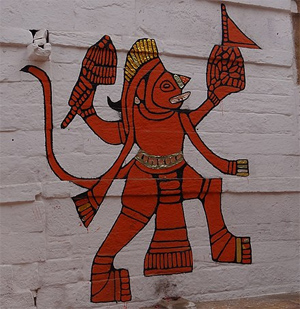
A wall painting of Hanuman from the fort of Jaisalmer, Rajasthan
It is the Panchamukhi form of Lord Anjaneya that Sri Raghavendra Tirtha had a vision of. Hence Madhva Brahmins who follow Dvaita Siddhanta, believe that Hanuman in the Panchamukhi form is Mukhya Prana Devaru (The Primordial Life-Giving deity) and is worshipped as son of Vayu. Sri Madhvacharya is worshipped as an incarnation of Lord Vayu. In Dvaita Siddhanta, the soul (Jivatma) may aspire to attain Vayu / Anjaneya / Panchamukha form, but Hari is Sarvottama (God). It is paraphrased as "Hari Sarvottama, Vayu Jeevottama". Thus Lord Anjaneya in the Panchamukha form occupies a place of prime importance and significance in Dvaita Siddhanta which has been propagated by Sri Madhwacharya, Sri Raghavendra Tirtha, Sri Vyasaraja Tirtha amongst others.
Texts
Hinduism
Ramayana
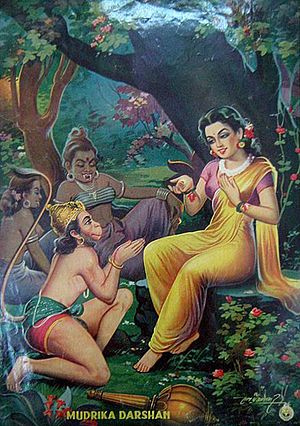
Hanuman finds Sita in the Ashoka grove, and delivers her Rama's ring.
The Sundara Kanda, the fifth book in the Ramayana, focuses on Hanuman. Hanuman meets Rama in the last year of the latter's 14-year exile, after the demon king Ravana had kidnapped Sita. With his brother Lakshmana, Rama is searching for his wife Sita. This, and related Rama legends are the most extensive stories about Hanuman.[65][66]
Numerous versions of the Ramayana exist within India. These present variant legends of Hanuman, Rama, Sita, Lakshamana and Ravana. The characters and their descriptions vary, in some cases quite significantly.[67]
Mahabharata
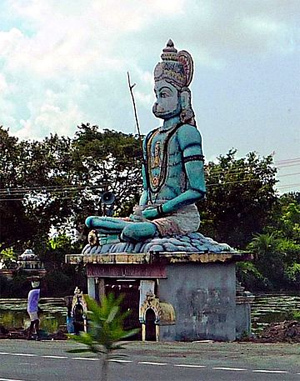
Roadside Hanuman shrine south of Chennai, Tamil Nadu.
The Mahabharata is another major epic which has a short mention of Hanuman. In Book 3, the Vana Parva of the Mahabharata, he is presented as a half brother of Bhima, who meets him accidentally on his way to Mount Kailasha. A man of extraordinary strength, Bhima is unable to move Hanuman's tail, making him realize and acknowledge the strength of Hanuman. This story attests to the ancient chronology of the Hanuman character. It is also a part of artwork and reliefs such as those at the Vijayanagara ruins.[68][69]
Other literature
Apart from Ramayana and Mahabharata, Hanuman is mentioned in several other texts. Some of these stories add to his adventures mentioned in the earlier epics, while others tell alternative stories of his life. The Skanda Purana mentions Hanuman in Rameswaram.[70]
In a South Indian version of Shiva Purana, Hanuman is described as the son of Shiva and Mohini (the female avatar of Vishnu), or alternatively his mythology has been linked to or merged with the origin of Swami Ayyappa who is popular in parts of South India.[2]
Hanuman Chalisa
The 16th-century Indian poet Tulsidas wrote Hanuman Chalisa, a devotional song dedicated to Hanuman. He claimed to have visions where he met face to face with Hanuman. Based on these meetings, he wrote Ramcharitmanas, an Awadhi language version of Ramayana.[71]
Relation with Devi or Shakti
The relation between Hanuman and Goddess Kali finds mention in the Krittivasi Ramayana.
Kṛttivāsī Rāmāyaṇ, composed by the fifteenth-century Bengali poet Krittibas Ojha, from whom it takes its name, is a rendition of the Rāmāyaṇa into Bengali. Written in the traditional Rāmāyaṇa Pā̃cālī form of Middle Bengali literature, the Kṛttivāsī Rāmāyaṇ is not just a rewording of the original Indian epic, but also a vivid reflection of the society and culture of Bengal across the period of its circulation, from the Middle Ages into the modern period. It was characterised by Dinesh Chandra Sen in 1911 as 'by far the most popular book in Bengal' and 'the Bible of the people of the Gangetic Valley'.
-- Krittivasi Ramayan, by Wikipedia
Their meeting takes place in the Yuddha Kanda of Ramayana in the legend of Mahiravana. Mahiravana was a trusted friend/brother of Ravana. After his son, Meghanatha was killed, Ravana sought Mahiravana, the King of Patalaloka's help to kill Rama and Lakshmana. One night, Mahiravana, using his maya, took Vibhishana's form and entered Rama's camp. There he cast the nidra mantra on the Vanar Sena, kidnapped Rama and Lakshmana and took them to Patala Loka. He was an adherent devotee of Devi and Ravana convinced him to sacrifice the valiant fighters of Ayodhya to the goddess, to which Mahiravana agreed. Hanuman, upon understanding the way to Patala from Vibhishana made haste to rescue his lords. On his journey, he met Makardhwaja who claimed of being Hanuman's son, being born from his sweat which was consumed by a Makara (crocodile). Hanuman defeated and tied him and went inside the palace. There he met Chandrasena who told about the sacrifice and the way to kill Ahiravana. Hanuman then shrunk his size to that of a bee and went towards the huge idol of Maha-Kali. He asked her to let him save Rama, and the fierce mother goddess agreed as Hanuman took her place while she slipped below. When Mahiravana asked the prince-sages to bow, they refused as they were of royal lineage and didn't know how to bow. So as Mahiravana was about to show them how to bow, Hanuman took his Pancha-mukha form (with the head of Garuda, Narasimha, Varaha, Hayagreeva and himself: each head signifying a particular trait. Hanuman courage and strength, Narasimha fearlessness, Garuda magical skills and the power to cure snake bites, Varaha health and exorcism and Hayagriva victory over enemies), blew the 5 oil lamps in 5 directions and severed the head of Mahiravana, thus killing him. He later took Shri Rama and Lakshmana on his shoulders and as he flew outside Shri Rama saw Makardhwaja tied with his tail. He immediately ordered Hanuman to crown him the King of Patala. The story of Ahiravan finds its place in the Ramayanas of the East. It can be found in the Bengali version of the Ramayana, written by Krittibash. The passage which talks about this incident is known as ‘Mahirabonerpala’. It is also believed that after being pleased with Hanuman, Goddess Kali blessed him to be her dwara-paal or gate-keeper and hence one finds Bhairava and Hanuman on either sides of the temple entrance of the Goddess' shrine. [72]
Buddhism
Hanuman appears with a Buddhist gloss in Tibetan (southwest China) and Khotanese (west China, central Asia and northern Iran) versions of Ramayana. The Khotanese versions have a Jātaka tales-like theme, but are generally similar to the Hindu texts in the storyline and character of Hanuman. The Tibetan version is more embellished, and without attempts to include a Jātaka gloss. Also, in the Tibetan version, novel elements appear such as Hanuman carrying love letters between Rama and Sita, in addition to the Hindu version wherein Rama sends the wedding ring with him as a message to Sita. Further, in the Tibetan version, Rama chides Hanuman for not corresponding with him through letters more often, implying that the monkey-messenger and warrior is a learned being who can read and write.[73][74]
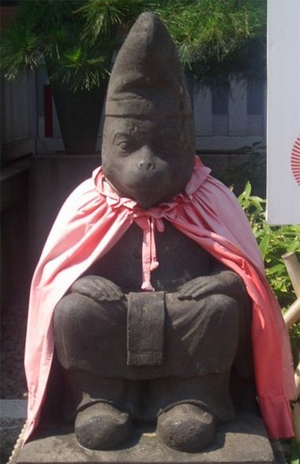
In Japan, icons of the divine monkey (Saruta Biko), guards temples such as Saru-gami at Hie Shrine.[75][76]
In the Sri Lankan versions of Ramayana, which are titled after Ravana, the story is less melodramatic than the Indian stories. Many of the legends recounting Hanuman's bravery and innovative ability are found in the Sinhala versions. The stories in which the characters are involved have Buddhist themes, and lack the embedded ethics and values structure according to Hindu dharma.[77] According to Hera Walker, some Sinhalese communities seek the aid of Hanuman through prayers to his mother.[78] In Chinese Buddhist texts, states Arthur Cotterall, myths mention the meeting of the Buddha with Hanuman, as well as Hanuman's great triumphs.[79] According to Rosalind Lefeber, the arrival of Hanuman in East Asian Buddhist texts may trace its roots to the translation of the Ramayana into Chinese and Tibetan in the 6th-century CE.[80]
In both China and Japan, according to Lutgendorf, much like in India, there is a lack of a radical divide between humans and animals, with all living beings and nature assumed to be related to humans. There is no exaltation of humans over animals or nature, unlike the Western traditions. A divine monkey has been a part of the historic literature and culture of China and Japan, possibly influenced by the close cultural contact through Buddhist monks and pilgrimage to India over two millennia.[75] For example, the Japanese text Keiranshuyoshu, while presenting its mythology about a divine monkey, that is the theriomorphic Shinto emblem of Hie shrines, describes a flying white monkey that carries a mountain from India to China, then from China to Japan.[81] This story is based on a passage in the Ramayana where the wounded hero asks Hanuman to bring a certain herbal medicine from the Himalayas. As Hanuman does not know the herb he brings the entire mountain for the hero to choose from. By that time a learned medicine man from Lanka discovered the cure and Hanuman brings the mountain back to where it came from. Many Japanese shinto shrines and village boundaries, dated from the 8th to the 14th centuries, feature a monkey deity as guardian or intermediary between humans and gods (kami).[75][76]
The Jātaka tales contain Hanuman-like stories.[82] For example, the Buddha is described as a monkey-king in one of his earlier births in the Mahakapi Jātaka, wherein he as a compassionate monkey suffers and is abused, but who nevertheless continues to follow dharma in helping a human being who is lost and in danger.[83][84]
The Mahakapi Jataka is one of the Jataka tales or stories of the former lives of the Buddha, when he was still a Bodhisattva, as a king of the monkeys[2] [Jataka Stories Or Birth-Legends Were Widely Known In The Third Century Bc. The Pail Work, Entitled The Jataka Contains 537 Birth-Stories Of The Buddha's Former Births. Each Story, Narrated By The Buddha, Opens With A Preface Relating The Particular Circumstance In The Buddha's Life, Revealing Some Events In The Long Series Of His Previous Existences As A Bodhisattva. At The End The Buddha Identifies The Different Actors In The Story In Their Present Births. These Stories Magnify The Glory Of The Buddha And Illustrate Buddhist Doctrines And Precepts By Appropriate Examples. The Foremost Interest Of These Legends Lies In Their Relation To Folklore Giving A Vivid Picture Of The Social Life And Customs Of Ancient India. E. B. Cowell, Translator. Edward Byles Cowell, FBA (1826-1903)was a noted translator of Persian poetry and the first professor of Sanskrit at Cambridge University. Cowell was born in Ipswich, the son of Charles Cowell and Marianne Byles. Elizabeth "Beth" Cowell, the painter, was his sister. -- Jataka Or Stories of the Buddha's Former Birth, Volumes 1-2, by E. B. Cowell 2000]
The story runs that the Bodhisattva was born as a monkey, ruler over 80,000 monkeys. They lived at a spot near the Ganges and ate of the fruit of a great mango tree. King Brahmadatta of Benares, desiring to possess the mangoes, surrounded the tree with his soldiers, in order to kill the animals, but the Bodhisattva formed a bridge over the stream with his own body and by this means enabled the whole tribe to escape into safety.
Devadatta, the jealous and wicked cousin of the Buddha, was in that life one of the monkeys and, thinking it a good chance to destroy his enemy, jumped on the Bodhisattva’s back and broke his heart.
The king, seeing the good deed of the Bodhisattva and repenting of his own attempt to kill him, tended him with great care when he was dying and afterwards gave him royal obsequies.
-- Mahakapi Jataka, by Wikipedia
Jainism
Main articles: Rama in Jainism and Salakapurusa
Paumacariya (also known as Pauma Chariu or Padmacharit), the Jain version of Ramayana written by Vimalasuri, mentions Hanuman not as a divine monkey, but as a Vidyadhara (a supernatural being, demigod in Jain cosmology). He is the son of Pavangati (wind deity) and Anjana Sundari. Anjana gives birth to Hanuman in a forest cave, after being banished by her in-laws. Her maternal uncle rescues her from the forest; while boarding his vimana, Anjana accidentally drops her baby on a rock. However, the baby remains uninjured while the rock is shattered. The baby is raised in Hanuruha.
Vimalasuri's Version
Vimalasuri's version is one of the most important and influential Jain story of Rama. Vimala Suri claims that the Ramayana of Valmiki is filled with illogical and false stories.[9] In his version, Kaikeyi is shown to be a generous and affectionate mother who wanted to stop Bharata from becoming a monk. For this, she wanted to give him the responsibility of a king. When Rama knew about it, he willingly went into exile.[10] Ravana was also called Dasamukha (ten-headed one) because when he was young, his mother gave him a necklace made of nine pearls. She could see his face reflected ninefold. Hence, he was named thus.[11] In Vimalsuri's Paumachariya, Rama married thrice when he was in exile. Lakshmana, his brother married eleven times. Ravana, was well known for his abilities in meditation and ascetic practices.[12] He was the king of Rakshasa, a kingdom of civilized and vegetarian people.[9] Sugriva was appointed by his brother Vali to become the king before Vali renounces the world and becomes a Jain monk.[9] Shambuka was accidentally killed by Lakshmana.[9] Ravana had passionate feelings for Sita. He said to have suffered in the end due to the effects of karma which was because of this vice. Lakshmana, Rama's brother kills Ravana. Both Ravana and Lakshmana go to hell for their actions where as Rama attains moksha(liberation). The vanaras were humans, belonging to a dynasty or clan which has a monkey as their emblem.[11] There are many arguments to which variant is actually authentic.
-- Rama in Jainism, by Wikipedia
There are major differences from the Hindu text: Hanuman is a supernatural being in Jain texts, (Rama is a pious Jaina who never kills anyone, and it is Lakshamana who kills Ravana.) Hanuman becomes a supporter of Rama after meeting him and learning about Sita's kidnapping by Ravana. He goes to Lanka on Rama's behalf, but is unable to convince Ravana to give up Sita. Ultimately, he joins Rama in the war against Ravana and performs several heroic deeds. Later Jain texts, such as Uttarapurana (9th century CE) by Gunabhadra and Anjana-Pavananjaya (12th century CE), tell the same story.
(In several versions of the Jain Ramayana story, there are passages that explain to Hanuman, and Rama (called Pauma in Jainism),(Hanuman, in these versions, ultimately renounces all social life become a Jain ascetic).

